Obama Administration
-
- Op/Ed: Fix the HMTF Now … or in 2027 Marine News, Jul 2016 #18
The Harbor Maintenance Trust Fund (HMTF) has been misused and underutilized for years, leaving U.S. ports and harbors in subpar conditions and disadvantaging the very shippers that pay to modernize and maintain them – to the tune of nearly $2 billion per year. In May, the U.S. House of Representatives’ (House) Committee on Transportation and Infrastructure (Committee) took a major step in the right direction by passing the Water Resources Development Act of 2016, which among other things, ensures that port and harbor infrastructure maintenance projects have access to the funding they need … in 2027.
The HMTF is funded through an excise tax assessed at identified ports on the value of commercial cargo shipped (excluding exported product), or cruise tickets sold, at a rate of .125 percent. The revenues collected are intended solely for port and harbor maintenance and modernization activities, including dredging channels, maintaining jetties and breakwaters, and operating locks along the coasts and in the Great Lakes. There is one catch: none of the money can be spent without an annual appropriation from Congress.In recent years, Congress has appropriated less than $1 billion of the roughly $2 billion collected each year, leaving the fund with more than $10 billion in excess cash. The blame does not lie with Congress alone. The Obama Administration, which oversees the Army Corps of Engineers (the federal body that performs port and harbor projects), is tasked with sending Congress an annual assessment of port and harbor funding needs, but the administration has specifically asked Congress to spend less than $1 billion per year in each of the President’s annual budget requests since assuming office in 2009. The net result is leaving some U.S. ports and harbors in a state of disrepair, and others with insufficient depths to accommodate cargo ships used for global trade.It is no surprise then that the American Society of Civil Engineers assigned U.S. ports and harbors a “C” grade in its most recent Infrastructure Report Card, and that the need for investment compounds with every passing day. Waterborne commerce already plays a major role in the U.S. economy, with approximately $1.4 trillion worth of goods moving through U.S. ports each year, generating $41 billion of federal, state, and local revenue annually. A nearly complete Panama Canal expansion project could push these numbers even higher – if we are ready.The “new” Panama Canal will accommodate significantly larger ships, accommodating vessels weighing as much as 14,000 TEUs – nearly triple the maximum weight 5,000 TEUs currently able to pass through the canal. Many U.S. harbors have not been sufficiently dredged to accommodate the larger ships commonly used in international trade, not to mention the mega-ships that will pass through the newly expanded canal. If the U.S. does not invest sufficiently to deepen these harbors – especially in the Atlantic and Gulf coasts, which do not possess the naturally occurring deep harbors found on the Pacific Coast – the U.S. economy will not reap the benefits offered by such large-scale improvements.The obvious questions then are:- Why do Congress and the Obama Administration agree each year to spend less than half of the $2 billion accrued annually, despite having a massive surplus?
- If the Committee acknowledges the need for a change, why are they waiting until 2027?
These two questions share one answer: very complicated budget rules. At first blush, this seems absurd, but there are two very real obstacles to fully funding harbor maintenance projects. First, “discretionary” budget caps and secondly, statutes and rules governing “mandatory” federal spending.By making this change effective in 2027, the Committee wisely sidestepped both politically thorny issues. The bill avoids discretionary budget caps by making the funds “available to the Secretary … without further appropriation…” This has the effect of changing how the spending is classified from “discretionary” to “mandatory.” Discretionary spending requires a specific appropriation from Congress each year, without which no funds can be spent from the relevant account. Conversely, mandatory spending is authorized to occur year after year on autopilot without Congressional approval unless and until Congress repeals such authority.The bill also escapes statutory “pay as you go,” or “Paygo” and “cut as you go,” or “Cutgo” rules by delaying the provision until 2027. Under Paygo laws, Congress must increase revenues (read: raise taxes) or cut spending in a sufficient amount to offset any new mandatory spending authorized by legislation. Paygo applies to the U.S. Senate (Senate) and the House. Similarly, Cutgo rules, which apply only to the House, require any new mandatory spending to be matched with an equal or greater amount of spending cuts. The primary difference being that in the House you cannot use new taxes to pay for new spending.However, these budgetary rules focus only on new spending authorized in a bill occurring in the first year, the aggregate of the first five years, and the total of the first ten years. Fiscal years 2027 and beyond are not within the scope of spending considered when applying these laws and rules (with certain exceptions) to a bill that passes in 2016. In other words, the Committee sidestepped the House budget rules by delaying the provision until 2027, outside the ten-year scoring window. Additional rules may be triggered when the Congressional Budget Office produces its official cost estimate for the bill, but for now it looks like the Committee threaded the needle.There are a finite number of opportunities for the federal government to improve infrastructure without spending a dime of taxpayer money. This is one of them. The Transportation and Infrastructure Committee should be applauded for its creativity and its leadership on this issue. Now the full House and Senate must follow suit and pass the Water Resources Development Act with this provision fully intact. Further, Congress should ensure all port and harbor funding needs are met until this provision kicks in (in 2027) by providing the Army Corps with sufficient funding to meet all project needs so long as the cost doesn’t exceed HMTF receipts for the year.The AuthorShane Skelton is the Executive Director of the Alliance for Innovation and Infrastructure. He can be reached at [email protected](As published in the July 2016 edition of Marine News) -
- U.S. Policies: Raising Red Flags Offshore Marine News, Oct 2013 #22
& Marine Spatial Planning: two of the biggest issues you never heard of. It’s also far more complicated than you might think. This summer, the Obama Administration released the innocuously named “Guide to Regional Marine Planning,” and across town, the House of Representatives passed the latest in a string
-
- Subchapter M Looms Operators and Suppliers Respond Marine News, May 2013 #10
operators go by the wayside, will we see foreign flagged vessels in U.S. inland waters? That’s not something too many would want to see, but if the Obama Administration has issued more Jones Act waivers in the past four years than have been granted the past six decades, then anything is possible. I’m just saying
-
- Where is Government Transparency? Marine News, Sep 2013 #26
without a clear explanation from the government on why it is has taken a leadership role and how the convention will impact U.S. businesses. The Obama Administration must reexamine its transparency policies. Billions of dollars have been spent funding FACA committees. Surely, some of this money could be spent
-
- Sailing into the Arctic’s Future Marine News, Oct 2016 #26
market. One of the first steps in providing that environment is to guarantee lease sales in the Alaska Arctic, which will be no small feat. The Obama administration is finalizing the 2017 – 2022 offshore leasing plan and anti-fossil fuel activists, fresh off their success in the Atlantic, have made removing
-
- OP/Ed: Obama’s Arctic Decision Undercut His Own Legacy Marine News, Mar 2017 #18
has vowed to fight any reversal of President Obama’s unilateral decision at every step. The same goes for undoing the myriad of harmful Obama administration regulatory actions imposed on the offshore oil and gas industry; there is no quick fix. However, even faced with these challenges, the outlook
-
- Energy’s Promising Future Threatened Marine News, Nov 2014 #20
data for the Atlantic OCS. This opens the door to a vital data-collection activity that has been kept off the table for more than 30 years. The Obama Administration deserves applause for taking this vital first step toward accurately assessing the resources of this new offshore area. However, some voices
-
- Offshore Renewables: The Future is Now Maritime Reporter, Jun 2015 #54
National Determined Contribution to the UN Framework Convention on Climate Change in advance of the meetings in Paris, and in that document the Obama administration has set a formal goal of reducing emissions by 26% to 28% below 2005 levels by the year 2025. While government targets for carbon emission
-
- The Versatile ATB Enters the LNG Game Marine News, Jul 2014 #36
chain. Flexibility in operation is an important aspect of barge design.” Natural gas, as a marine fuel, is strongly supported and endorsed by the Obama Administration. FMC Commissioner Doyle, speaking last month at the Vancouver-based LNG conference, also left no doubt as to where he thinks things are going
-
- Jumping Off the Fiscal Cliff? Maritime Reporter, May 2013 #14
DOT, the Maritime Administration is funded at the FY2012 level minus the five percent cut attributable to sequestration, described below. Since the Obama Administration has never included funding for the title XI loan guarantee program in its budget, it is unlikely that new funds have been appropriated for this
-
- Danger Lurking: Above & Below the Surface Marine News, Aug 2013 #34
platforms have been reefed since 2010 while more than 200 platforms have been removed yearly since then, according to BSEE. Three years ago, the Obama Administration tightened rules for plugging unused wells and removing old platforms and pipelines in the Gulf as part of a crackdown following the 2010 BP
-
- Arctic Coast Guard Forum: Eyes and Ears Up North Maritime Reporter, Dec 2015 #10
and charted much of the coastal waters of southern Greenland, but adequate charts for the northern portion of this large island are lacking. The Obama Administration published a National Strategy for the Arctic Region in 2013. The U.S. Coast Guard quickly complemented this with its Arctic Strategy. The U
-
 )
March 2024 - Marine Technology Reporter page: 6
)
March 2024 - Marine Technology Reporter page: 6MTR Editorial Advisors Gallaudet Hardy The Honorable Tim Gallaudet, Kevin Hardy is President PhD, Rear Admiral, U.S. of Global Ocean Design, Navy (ret) is the CEO of creating components and Ocean STL Consulting and subsystems for unmanned host of The American Blue vehicles, following a career
-
 )
April 2024 - Maritime Reporter and Engineering News page: 27
)
April 2024 - Maritime Reporter and Engineering News page: 27RADM PHILIP SOBECK, MILITARY SEALIFT COMMAND With COVID, we had to make some hard choices for our Do your CIVMARs have upward mobility? mariners because we couldn’t rotate. Many of our mariners The Navy has Sailors who become “Mustangs,” and work found other employment, and were able to use their skills
-
 )
April 2024 - Marine News page: 35
)
April 2024 - Marine News page: 35Capt. Josh Ferguson, master of the eWolf. Administration (MARAD), which all provided ? nancial support and other resources. “This tug becomes somewhat commercially viable be- cause of the grant process,” Manzi said. “Unlike a ferry service that’s paid for by tax dollars, we have to collect fares and
-
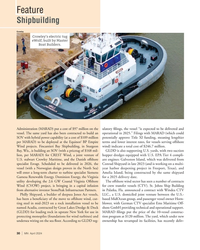 )
April 2024 - Marine News page: 30
)
April 2024 - Marine News page: 30Feature Shipbuilding Crowley Crowley’s electric tug eWolf, built by Master Boat Builders. Administration (MARAD) put a cost of $97 million on the ulatory ? lings, the vessel “is expected to be delivered and vessel. The same yard has also been contracted to build an operational in 2025.” Filings with
-
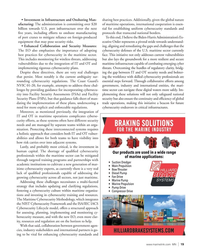 )
April 2024 - Marine News page: 19
)
April 2024 - Marine News page: 19• Investment in Infrastructure and Onshoring Man- sharing best practices. Additionally, given the global nature ufacturing: The administration is committing over $20 of maritime operations, international cooperation is essen- billion towards U.S. port infrastructure over the next tial for establishing
-
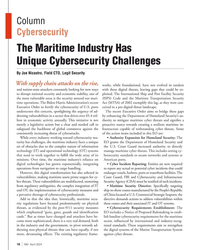 )
April 2024 - Marine News page: 18
)
April 2024 - Marine News page: 18Column Cybersecurity The Maritime Industry Has Unique Cybersecurity Challenges By Joe Nicastro, Field CTO, Legit Security With supply chain attacks on the rise, works, while foundational, have not evolved in tandem and nation-state attackers constantly looking for new ways with these digital threats
-
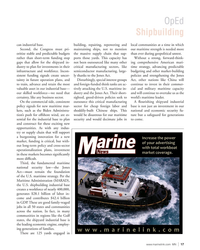 )
April 2024 - Marine News page: 17
)
April 2024 - Marine News page: 17OpEd Shipbuilding can industrial base. building, repairing, repowering and local communities at a time in which Second, the Congress must pri- maintaining ships, not to mention our maritime strength is needed more oritize stable and predictable budgets the massive supply chain that sup- than ever
-
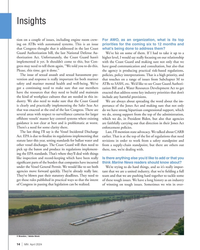 )
April 2024 - Marine News page: 14
)
April 2024 - Marine News page: 14Insights tion on a couple of issues, including engine room crew- For AWO, as an organization, what is its top ing on ATBs with automated systems. This is an issue priorities for the coming six to 12 months and that Congress thought that it addressed in the last Coast what’s being done to address them? Gua
-
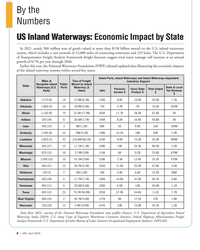 )
April 2024 - Marine News page: 8
)
April 2024 - Marine News page: 8By the Numbers US Inland Waterways: Economic Impact by State In 2021, nearly 500 million tons of goods valued at more than $158 billion moved on the U.S. inland waterways system, which includes a vast network of 12,000 miles of connecting waterways and 219 locks. The U.S. Department of Transportation
-
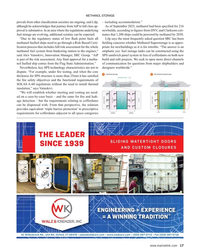 )
February 2024 - Maritime Reporter and Engineering News page: 17
)
February 2024 - Maritime Reporter and Engineering News page: 17METHANOL STORAGE provals from other classi? cation societies are ongoing, said Lilp, – including accommodation.” although he acknowledges that journey from AiP to full class ap- As of September 2023, methanol had been speci? ed for 216 proval is substantive. In an area where the regulations underlying
-
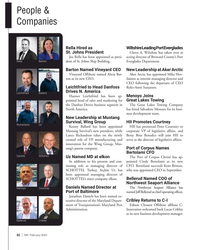 )
February 2024 - Marine News page: 42
)
February 2024 - Marine News page: 42People & Companies Rella Hired as Wiltshire Leading Port Everglades St. Johns President Glenn A. Wiltshire has taken over as Joe Rella has been appointed as presi- acting director of Broward County’s Port Rella Barton dent of St. Johns Ship Building. Everglades Department. Barton Named Vineyard CEO New
-
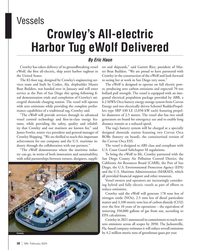 )
February 2024 - Marine News page: 38
)
February 2024 - Marine News page: 38Vessels Crowley’s All-electric Harbor Tug eWolf Delivered By Eric Haun Crowley has taken delivery of its groundbreaking vessel ers and shipyards,” said Garrett Rice, president of Mas- eWolf, the ? rst all-electric, ship assist harbor tugboat in ter Boat Builders. “We are proud to have partnered with the
-
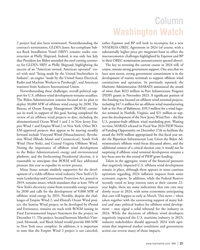 )
February 2024 - Marine News page: 21
)
February 2024 - Marine News page: 21Column Washington Watch 2 project had also been terminated. Notwithstanding the rather Equinor and BP will look to recompete for a new contract’s termination, GLDD’s Jones Act-compliant Sub- NYSERDA OREC Agreement in 2024 (of course, with a sea Rock Installation Vessel (SRIV) remains under con- substantial
-
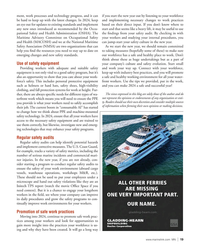 )
February 2024 - Marine News page: 19
)
February 2024 - Marine News page: 19ment, work processes and technology progress, and it can if you start the new year out by listening to your workforce be hard to keep up with the latest changes. In 2024, keep and implementing necessary changes to work practices an eye out for updates to existing standards and implement based on their
-
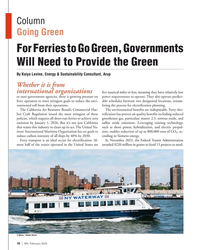 )
February 2024 - Marine News page: 16
)
February 2024 - Marine News page: 16Column Going Green For Ferries to Go Green, Governments Will Need to Provide the Green By Kaiya Levine, Energy & Sustainability Consultant, Arup Whether it is from international organizations ? ve nautical miles or less, meaning they have relatively low or state government agencies, there is growing
-
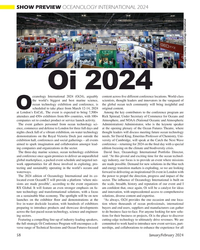 )
January 2024 - Marine Technology Reporter page: 58
)
January 2024 - Marine Technology Reporter page: 58SHOW PREVIEW OCEANOLOGY INTERNATIONAL 2024 All images courtesy Oceanology International Oi 2024 ceanology International 2024 (Oi24), arguably content across ? ve different conference locations. World-class the world’s biggest and best marine science, scientists, thought leaders and innovators in the
-
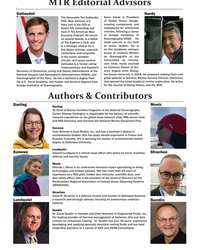 )
January 2024 - Marine Technology Reporter page: 6
)
January 2024 - Marine Technology Reporter page: 6MTR Editorial Advisors Gallaudet Hardy The Honorable Tim Gallaudet, Kevin Hardy is President PhD, Rear Admiral, U.S. of Global Ocean Design, Navy (ret) is the CEO of creating components and Ocean STL Consulting and subsystems for unmanned host of The American Blue vehicles, following a career
-
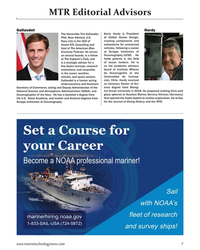 )
November 2023 - Marine Technology Reporter page: 7
)
November 2023 - Marine Technology Reporter page: 7MTR Editorial Advisors Gallaudet Hardy The Honorable Tim Gallaudet, Kevin Hardy is President PhD, Rear Admiral, U.S. of Global Ocean Design, Navy (ret) is the CEO of creating components and Ocean STL Consulting and subsystems for unmanned host of The American Blue vehicles, following a career
-
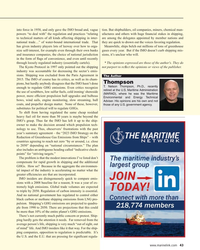 )
December 2023 - Maritime Reporter and Engineering News page: 43
)
December 2023 - Maritime Reporter and Engineering News page: 43into force in 1958, and only gave the IMO broad and, vague tion. But shipbuilders, oil companies, miners, chemical man- powers “to deal with” the regulation and practices “relating ufactures and others with huge ? nancial stakes in shipping, to technical matters of all kinds affecting shipping in inter-
-
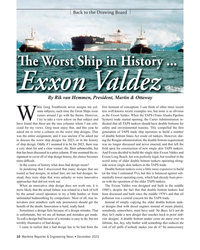 )
December 2023 - Maritime Reporter and Engineering News page: 10
)
December 2023 - Maritime Reporter and Engineering News page: 10Back to the Drawing Board T e Worst Ship in History ... Exxon Valdez By Rik van Hemmen, President, Martin & Ottaway hile Greg Trauthwein never assigns me col- ? rst moment of conception. I can think of other more recent umn subjects, each time the Great Ships issue less well-known recent examples too
-
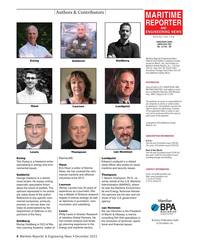 )
December 2023 - Maritime Reporter and Engineering News page: 4
)
December 2023 - Maritime Reporter and Engineering News page: 4Authors & Contributors MARITIME REPORTER AND ENGINEERING NEWS M A R I N E L I N K . C O M ISSN-0025-3448 USPS-016-750 No. 12 Vol. 85 Maritime Reporter/Engineering News Ewing Galdorisi Goldberg (ISSN # 0025-3448) is published monthly except for March, July, and October by Maritime Activity Reports, Inc.
-
 )
November 2023 - Marine News page: 44
)
November 2023 - Marine News page: 44Length: 525 ft. Breadth: 88.5 ft. Feature Depth: 55.1 ft. Draft, design: 21.4 ft. Range: 10,000+ miles @ 18 knots Propulsion: Diesel Electric Great Vessels of 2023 Engines: Wabtec (4) separated in two engine rooms MARAD Total installed power: 16,800 kW Emergency generator: 900kW Electric propulsion
-
 )
November 2023 - Marine News page: 39
)
November 2023 - Marine News page: 39‘Vessel Construction Manager (VCM)’ When asked about new industry trends and develop- ments Paxton and Zorensky quickly referenced delivery, in September, of Philly Shipyard’s Empire State, the new purpose-built training vessel for the SUNY Maritime Col- lege, the ? rst of a number of such vessels to be
-
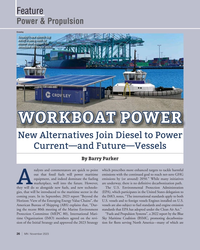 )
November 2023 - Marine News page: 26
)
November 2023 - Marine News page: 26Feature Power & Propulsion Crowley Crowley’s new electric tug eWolf is being built by Master Boat Builders for scheduled delivery in 2024. WORKBOAT POWERWORKBOAT POWER New Alternatives Join Diesel to Power Current—and Future—Vessels By Barry Parker nalysts and commentators are quick to point which
